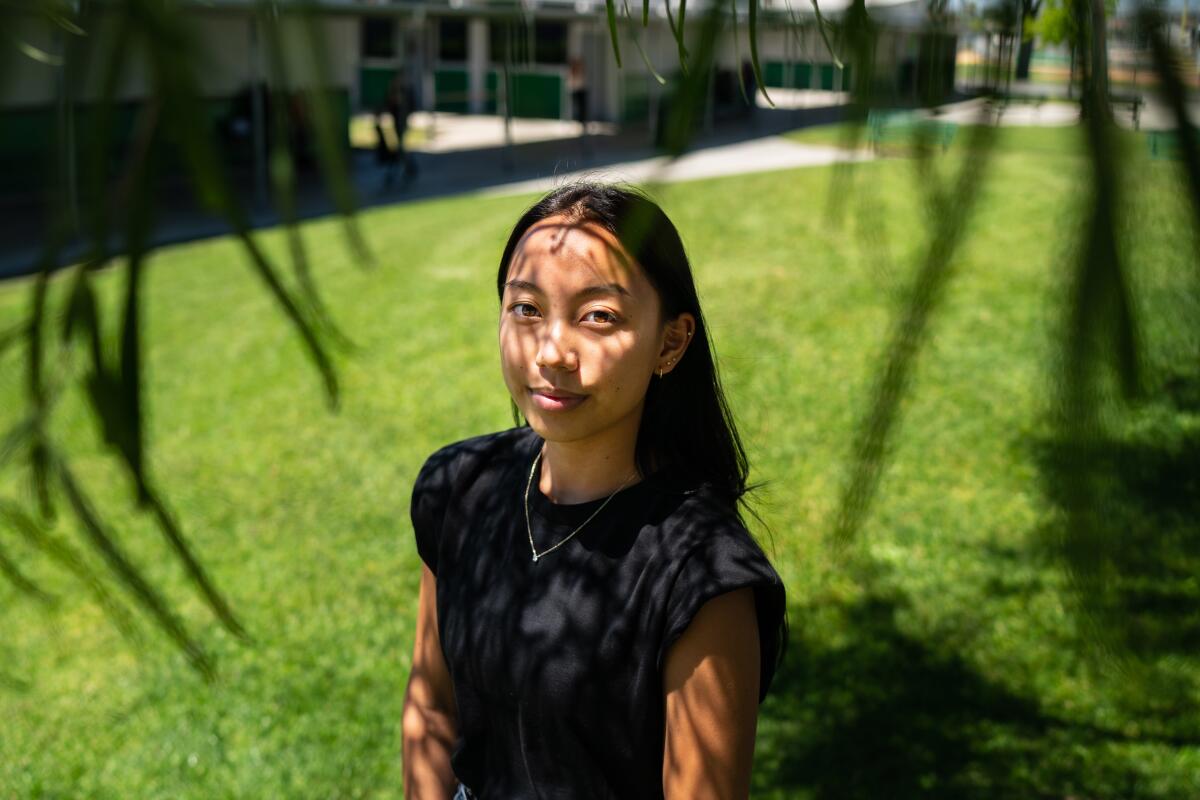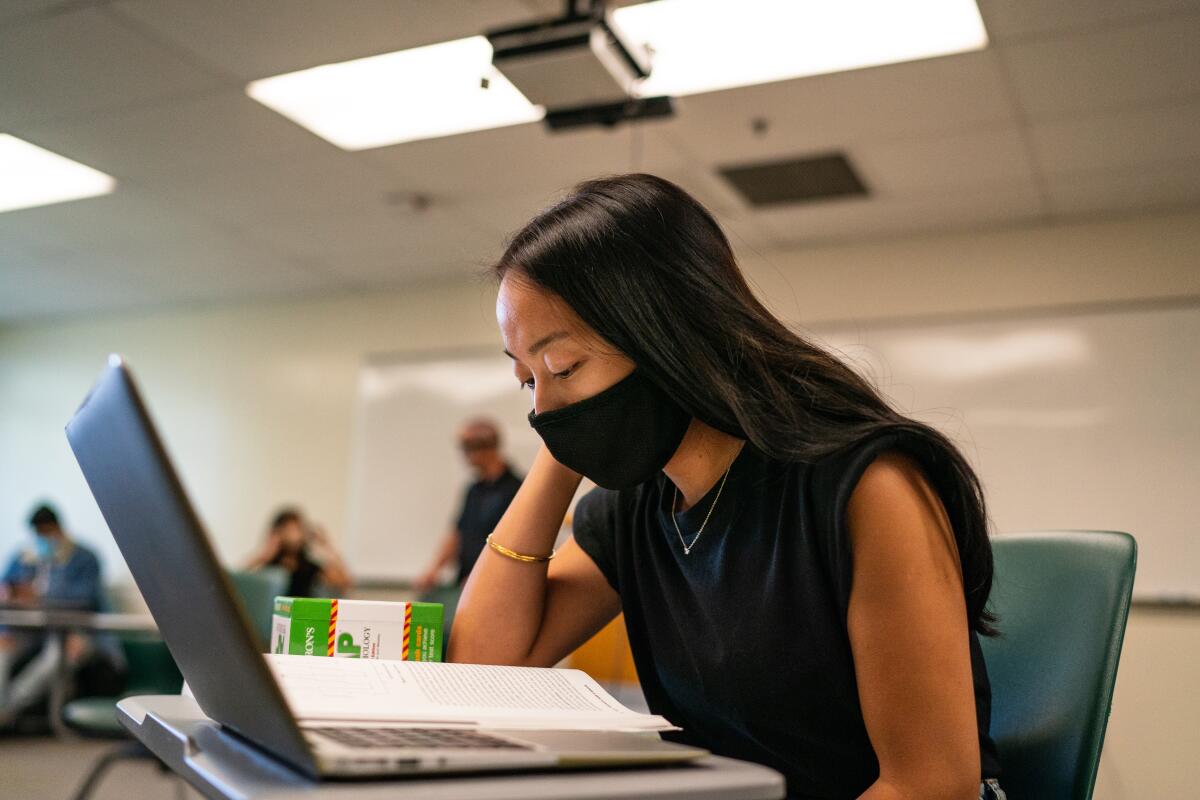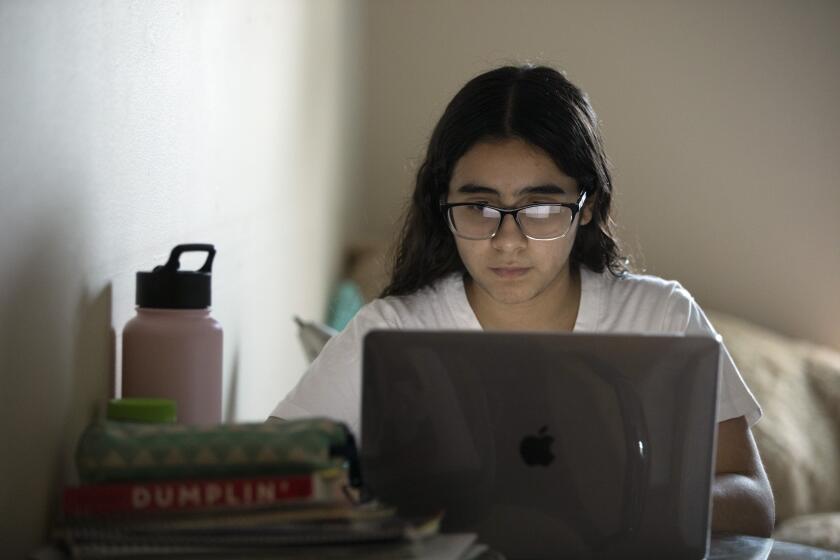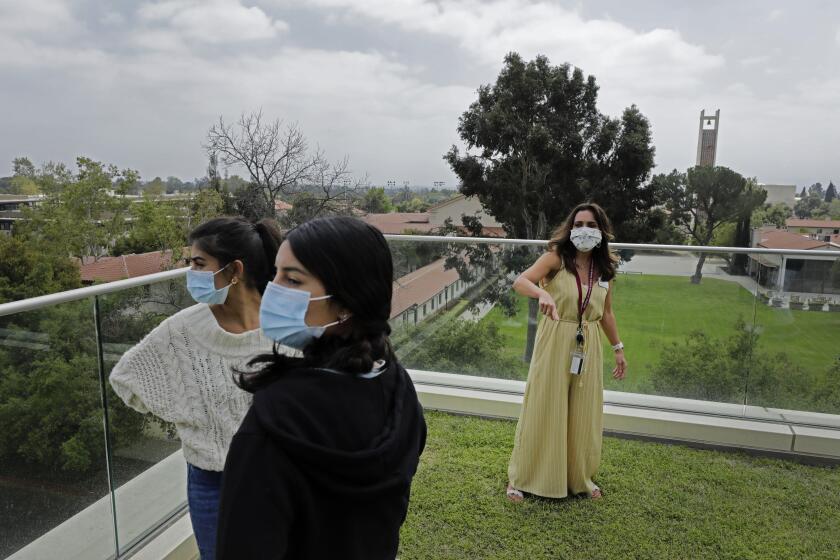Here’s what UC says about the chances of being plucked from massive waitlists

- Share via
Anika Madan, a senior at Sunny Hills High in Fullerton, had a loaded school resume when she applied to six University of California campuses for admission this fall: a 4.6 GPA, 11 college-level courses, student leadership positions and community service building robotic hands for people with disabilities.
She was accepted to UC campuses at Irvine, Riverside and Santa Barbara — but wait-listed at Berkeley, Davis and San Diego.
Once again she is on edge — along with tens of thousands of others — as yet another nail-biting phase of a record-breaking UC admission season begins this week. Campuses are diving into their massive waitlists, selecting students to fill the seats of those who turned down UC offers by the May 1 college decision day. For the waitlisted, this next round is sparking more anxiety, frustration and even defiance as they try to decide whether to hold out for an offer from a favored campus or just move on.
So what are the chances of being plucked from a waitlist?
Last year, UC undergraduate campuses extended more than 112,000 offers to be placed on a waitlist and students accepted more than half of them. UC ultimately offered about 34,000 seats to waitlisted students — more than double the number in 2019. Admission rates of waitlisted students rose at UCLA to 19% in 2020 from 13% in 2019. They increased during that same period at San Diego to 27% from 22%; Irvine to 24% from 19%; Riverside to 67% from 34%; and Santa Cruz to 86% from 62%. Berkeley and Davis also substantially increased their offers to 1,668 and 4,282, respectively, last year over 2019, but their admission rates were not immediately available.
The problem is, last year is hardly a guide, and uncertainties rule the season.
UC admission directors say the pandemic threw off their tried and true prediction models about who would enroll last fall as thousands of admitted students decided to pass on a year of online classes and substantially shuttered dorms. That, in turn, caused campuses to scramble to fill vacated seats with an unusually high number of waitlisted students.
UC Berkeley, for instance, was hit by a last-minute enrollment loss of about 800 students last fall — costing the campus $60 million in nonresident student tuition, Chancellor Carol Christ told UC regents last year. As a result, Berkeley offered admission to 571 more waitlisted students than in 2019.
To ensure enrollment goals can be reached, several UC campuses extended at least the same number or more of waitlist offers this year, officials said.
University of California admissions officers explain their decisions in a year of record applications that brought widespread heartbreak and some joy for high school seniors competing for spots.
“Unpredictable isn’t a strong enough word to describe last summer,” said Gary Clark, UCLA director of undergraduate admissions. “There are some years when we go to the waitlist for a good number of students, but there are other years when ... there may be very, very few waitlist offers. So what happens in a previous admission cycle is not a predictor of what’s going to happen in a future admission cycle because every year is going to be different.”
UC Santa Barbara offers an extreme example. Last year, the university extended admission offers to 97% of wait-listed students, rocketing from 10% the previous year. Campus admissions director Lisa Przekop said she doesn’t expect that spike to happen again this year but her team has expanded the waitlist again to hedge their bets.
“The big question that we’re all very nervous about is we don’t know what the student behavior will be,” she said.
The pandemic has upended traditional indicators that helped the guesswork. Without actual campus tours and open houses, it’s more difficult to gauge student interest, Przekop said. Although UC intends to carefully reopen this fall with some campus dorming and in-person classes, an unexpected surge in COVID-19 cases could cause another shutdown and loss of students. The economy is improving, but should it take a turn for the worse and students leave school, that, too, could affect waitlist action.
“Are we on the other side of the pandemic? Is the economy strong enough? Who knows?” said Adele Brumfield, UC San Diego associate vice chancellor of enrollment management. “My job and the job of my team is to guard against the unknowns to make sure that we have enough students in the hopper. But I do feel confident that we will meet our enrollment goal. That’s the blessing of having such a robust applicant pool with so many talented students.”
But being a member of the waitlist pool can be disheartening. Anika, for instance, has committed to Irvine but is hoping to get off the waitlist at Davis, her top choice because of the green campus environment, highly rated medical school and rich variety of classes that fit her plans for a psychology major.
“I was happy I got some acceptances but bummed that I need to wait more,” Anika said. “The waitlist process is very long and grueling.”

Some students aren’t willing to wait around. Nichola Soleta, a Buena Park High senior, had hoped she would win admission to a UC campus with her 3.8 GPA, unusual life living around the world with two mothers in the military, varsity cheer, a clothing business startup, and leadership in yearbook and other school clubs. But she was denied at Berkeley, San Diego and Irvine and wait-listed at Santa Barbara and Riverside.
She regards Santa Barbara as the best fit because it offers an elementary education program perfectly suited to her career goals. But she’s decided to commit to Cal State Fullerton, which offers a similar teaching program, and doesn’t plan to change her mind.
It’s not what she imagined for herself. She always expected to go to a UC school, she said, with the prestige, the connections, the independence of living in student housing away from home.
Accepted students are in the power position this month as competitive colleges try to impress them to say yes in a year of record applications to the University of California and other elite schools.
“The way that we’re raised, especially in California, is that you’re told that UC is the best school you could possibly get into that’s not an Ivy League,” Nichola said. “But when I look at the fact that I got wait-listed, it kind of gives you the sense that I wasn’t enough. I feel a greater worth at a school that accepted me, like they value you.”
For high school teachers and counselors, such stories are becoming more common every year as competition for UC seats intensifies. Ten years ago, for instance, 28% of Santa Monica High applicants to UCLA were admitted; that declined to 18% last year. Although final admission numbers for this year aren’t in, school officials say the outcomes seem even worse.
“This year was really brutal,” said Claudia Bautista-Nicholas, a Santa Monica High Spanish teacher. “A lot of kids got turned down by every UC they applied to. Sadly, April has become depression month for us now because they get all these rejections.”
Cyndy McDonald, a Central Valley independent college counselor, said waitlisted students need to face the fact that chances of a UC admission offer are generally low.
“It’s not like going to Costco and if you wait long enough you’ll get in,” she said. “Accept the waitlist offer but don’t count on it. Pick a school you’ve been admitted to and move forward. That will help build realistic expectations, because for some students, it’s so demoralizing. They think, ‘Nobody wanted me.’”
The dismay among such students pains UC admission directors, who say that they wait-list only excellent applicants who can succeed at the rigorous public research university, but that state funding controls enrollment sizes.
“The thing that I think is really important is that we admitted 15,500 California residents this year — and the next 15,000 were also fantastic students any university in the country would be happy to have,” said Dale Leaman, executive director of UC Irvine’s undergraduate admissions office. “It’s not just a raw number on a waitlist.”
Unlike some private colleges, UC does not rank waitlisted students nor take their ability to pay into account when offering them admission. Officials say their selections are generally a continuation of the regular admission process, with consideration given to students’ original scores from application readers and whether their intended areas of study fill enrollment holes that year.
At UC Davis, for instance, half or more of students wait-listed for religious studies, mathematics, and animal science and management were offered admission last year, a significant increase over 2019. Only 1 in 5 students was admitted into some of the most popular majors — managerial economics, computer science and psychology, for instance.
UC Riverside more than quadrupled the number of admission offers to waitlisted students for the College of Engineering last year but reduced the number of offers for School of Education applicants.
Emily Engelschall, UC Riverside admissions director, said waitlisted students should not submit letters of continued interest, a declaration to accept an admission offer or a pledge to defer enrollment for a year — actions commonly suggested by college consultants to boost admission chances — because the campus won’t consider them. But students accepting a waitlist offer may be allowed to write a 200-word statement on why they believe the campus in question is the right place for them.
At UC Santa Cruz, admissions director Michelle Whittingham said she wouldn’t even use waitlists if she didn’t have to. But enrollment prediction — a discipline that aims to meld the science of data analysis with the guesswork of anticipating teenage whims — can be dicey. Miscalculations have led to fiascos over the last several years at UC Irvine, UC Santa Cruz and Cal Poly San Luis Obispo, when hundreds more students accepted admission offers than anticipated. Admitting a conservative number of students and then filling the gaps with waitlists has proved to be a safer bet, if more emotionally fraught for applicants.
“Most important words for students to understand: We see you, we recognize your accomplishments, and we value you,” Whittingham said. “If our predictions of student behavior were 100% accurate and capacity never changed, we would not need waitlists. I fully recognize how hard it is for students and families. The advice is for them to keep their options open and to please be patient with the process.”
Anh Nguyen is willing to heed that advice. The Buena Park High senior, who emigrated from Vietnam at age 6 with no English language ability but now ranks near the top of her class with a 4.67 GPA, already has a great college option: a full ride to UC Irvine to major in biology. She’s committed there for now, but UCLA is her dream school. If she can get off the waitlist, she plans to switch.
So she continues to wait.
More to Read
Sign up for Essential California
The most important California stories and recommendations in your inbox every morning.
You may occasionally receive promotional content from the Los Angeles Times.













